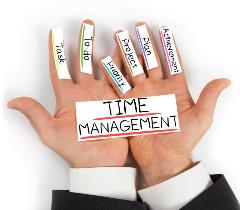Studying for the Certified Meeting Professional exam? MPI Ottawa has you covered!
Learn More
Check out all the exciting events taking place in the upcoming 2023/2024 year!
Learn More

Coaching Corner - Time Management: Learn How to Thrive and Not Just Survive!

Tick tock tick tock… Tick tock tick tock… Tick tock tick tock…
Time doesn’t just stop when you want it to, it doesn’t wait around for you to figure out your next move, it is continuous! Instead of feeling anxious about how you never have enough time in one day and feeling like you are working against time, learn how to take full advantage of every second of your time in a day to ensure you maximise your results and increase productivity!
Learn how to work with time opposed to against it! Don’t just survive your work day but learn how to thrive using these techniques and practices that I picked up in a recent course (Biron, 2017). Now it’s time to share these techniques with you in hopes that these three short and simple tips will help you as much as they have helped me. Try implementing them into your everyday workday and see how much time you can save!

1. Daily Map:
Setup your week by using these six simple steps:
-
Brainstorm: Make a list of things that you want to accomplish this week;
-
Remember to be realistic! Take a look at the pre-scheduled meetings that you already have lined up and schedule worktime accordingly.
-
-
Identify what is urgent: Draft your list starting with what is most urgent to least urgent;
-
Remember to look ahead! Is there something that you need time to prepare for an upcoming meeting or presentation later in the week or next week? Is there a project that you need to work before a colleague can do their part of the work?
-
-
Time of day: Determine what time of day you are most productive;
-
Remember that everyone is different – find what works best for you! Some people are most productive after their morning coffee and others are more productive in the afternoon after feeding their brain post-lunch.
-
-
Estimate Time: Breakdown each task and estimate how long each will take;
-
Remember to try to make reasonable estimates! Your time is valuable and you need to use it wisely.
-
-
Tasks vs. Projects: Determine what is a task (1 hour or less) and what is a project (1 hour or more);
-
Remember to establish the difference before you hop into working! If operationally feasible, turn off your email notifications while working on time-consuming projects; this will eliminate your temptation to answer your emails for hours on end instead of working on your tasks or projects.
-
-
Calendar: Schedule each task and project into your calendar;
-
Remember, don’t overschedule your calendar. Don’t be shy to block time in your calendar for you to do work; this will let your colleagues know that you have dedicated a certain amount of time for a task/project. Ensure you do not overschedule and leave some empty time in your schedule in case your colleagues need to schedule a meeting with you.
-

2. “Bite sized pieces”:
-
Break projects up that are more than an hour;
-
Schedule 30 minute timeslots into your calendar each day with the overall goal to complete one project by the end of the week;
-
Avoid getting overwhelmed by big projects – starting the work in shorter increments is the key.

3. Email Template:
Draft emails and email responses using this simple three step template:
-
Subject line: Catchy, informative, and/or deadline;
-
Subject lines are key! Some people quickly scan their emails on their phones and some can only see the subject line. Drafting a catchy but informative subject line will prompt your reader to open and hopefully answer your email faster.
-
-
5 W’s & 1 H: Who, what, where, when, why, and how;
-
Answering the 5 W’s & 1 H will eliminate a lot of the back and forth questions via email.
-
-
W.I.I.F.T.: What is it in for them?
-
Your email has to have a purpose – ensure it is clear what the reader will get out of reading and responding to your email.
-
The use of this template will eliminate a lot of back and forth and time consuming email trails. Hashing out a lot of the information at once and anticipated questions that might be asked will save you lots of time!
Now it’s time to implement these techniques and practices into your everyday work to ensure you learn how to thrive and not just survive!
If you have any questions about this article, student membership or have topics you would like to see in future “Coaching Corner” articles, please don’t hesitate to send a message to students@mpiottawa.ca.
Biron, S. (2017) Practical Time & Workload Management: Participant Manual. PMC Training Performance Management Consultants, 3-43.
 Article Written By Angelita Aboukassam, Royal College of Physicians and Surgeons of Canada
Article Written By Angelita Aboukassam, Royal College of Physicians and Surgeons of Canada
Article edited by Rozanne Lyons, CMP, Intertask Conferences



Leave a commentOrder by
Newest on top Oldest on top